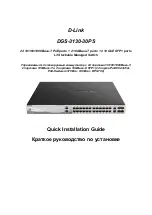
xStack® DGS-3620 Series Managed Switch Web UI Reference Guide
212
PIM-SSM
The Source Specific Multicast (SSM) feature is an extension of IP multicast where datagram traffic is forwarded to
receivers from only those multicast sources to which the receivers have explicitly joined. For multicast groups in
SSM range, only source-specific multicast distribution trees (no shared trees) are created.
The Internet Assigned Numbers Authority (IANA) has reserved the address range from 232.0.0.0 to
232.255.255.255 for SSM applications and protocols. The Switch allows SSM configuration for an arbitrary subset
of the IP multicast address range from 224.0.0.0 to 239.255.255.255.
PIM-DM
The Protocol Independent Multicast - Dense Mode (PIM-DM) protocol should be used in networks with a low delay
(low latency) and high bandwidth as PIM-DM is optimized to guarantee delivery of multicast packets, not to reduce
overhead.
The PIM-DM multicast routing protocol is assumes that all downstream routers want to receive multicast messages
and relies upon explicit prune messages from downstream routers to remove branches from the multicast delivery
tree that do not contain multicast group members.
PIM-DM has no explicit ‘join’ messages. It relies upon periodic flooding of multicast messages to all interfaces and
then either waiting for a timer to expire (the Join/Prune Interval) or for the downstream routers to transmit explicit
‘prune’ messages indicating that there are no multicast members on their respective branches. PIM-DM then
removes these branches (‘prunes’ them) from the multicast delivery tree.
Because a member of a pruned branch of a multicast delivery tree may want to join a multicast delivery group (at
some point in the future), the protocol periodically removes the ‘prune’ information from its database and floods
multicast messages to all interfaces on that branch. The interval for removing ‘prune’ information is the Join/Prune
Interval.
PIM-SM-DM
In the PIM-SM, RP is a key point for the first hop of the sender. If the first hop does not have RP information when
the sender sends data out, it will drop the packet and do nothing. Sparse-Dense mode will be useful in this
condition. In Sparse-Dense mode, the packets can be flooded to all the outgoing interfaces and pruning/joining
(prune/graft) can be used to control the outgoing interface list if RP is not found. In other words, the PIM Sparse-
Dense mode is treated in either the sparse mode or dense mode of the operation; it depends on which mode the
multicast group operates. When an interface receives multicast traffic, if there is a known RP for the group, then the
current operation mode on the interface is sparse mode, otherwise the current operation mode on the interface will
be dense mode.
PIM for IPv4
PIM Global Settings
This window is used to configure PIM global state and the parameter settings for the PIM distribution tree on the
Switch.
To view the following window, click
L3 Features > IP Multicast Routing Protocol > PIM > PIM for IPv4 > PIM
Global Settings
, as shown below:
Figure 5-80 PIM Global Settings window
The fields that can be configured are described below:
Parameter
Description
PIM Global State
Click the radio buttons to enable or disable PIM global state.
Summary of Contents for DGS-3620-28PC-EI
Page 1: ......
















































